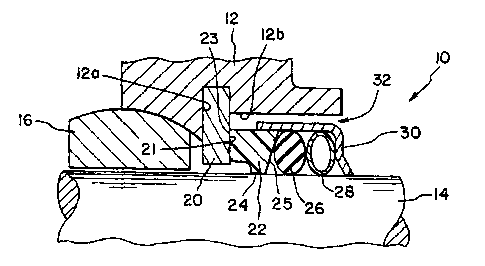Some of the information on this Web page has been provided by external sources. The Government of Canada is not responsible for the accuracy, reliability or currency of the information supplied by external sources. Users wishing to rely upon this information should consult directly with the source of the information. Content provided by external sources is not subject to official languages, privacy and accessibility requirements.
Any discrepancies in the text and image of the Claims and Abstract are due to differing posting times. Text of the Claims and Abstract are posted:
| (12) Patent Application: | (11) CA 2396493 |
|---|---|
| (54) English Title: | MECHANICAL FACE SEAL DESIGNS FOR SMALL SHAFTS |
| (54) French Title: | MODELES DE JOINT TOURNANT A PORTEE PLANE POUR ARBRES DE PETITE TAILLE |
| Status: | Deemed Abandoned and Beyond the Period of Reinstatement - Pending Response to Notice of Disregarded Communication |
| (51) International Patent Classification (IPC): |
|
|---|---|
| (72) Inventors : |
|
| (73) Owners : |
|
| (71) Applicants : |
|
| (74) Agent: | MOFFAT & CO. |
| (74) Associate agent: | |
| (45) Issued: | |
| (22) Filed Date: | 2002-08-01 |
| (41) Open to Public Inspection: | 2003-02-01 |
| Examination requested: | 2002-08-01 |
| Availability of licence: | N/A |
| Dedicated to the Public: | N/A |
| (25) Language of filing: | English |
| Patent Cooperation Treaty (PCT): | No |
|---|
| (30) Application Priority Data: | ||||||
|---|---|---|---|---|---|---|
|
A drive mechanism includes a housing, a shaft, and a face seal system. The
shaft
is mounted within the housing and is capable of being rotatably driven. The
face seal
system is positioned intermediate the housing and the shaft, the face seal
system being
configured for promoting at least one of a substantially constant load versus
deflection
curve and a substantially flat loading curve with respect to wear thereof.
Note: Claims are shown in the official language in which they were submitted.
Note: Descriptions are shown in the official language in which they were submitted.

2024-08-01:As part of the Next Generation Patents (NGP) transition, the Canadian Patents Database (CPD) now contains a more detailed Event History, which replicates the Event Log of our new back-office solution.
Please note that "Inactive:" events refers to events no longer in use in our new back-office solution.
For a clearer understanding of the status of the application/patent presented on this page, the site Disclaimer , as well as the definitions for Patent , Event History , Maintenance Fee and Payment History should be consulted.
| Description | Date |
|---|---|
| Time Limit for Reversal Expired | 2007-08-01 |
| Application Not Reinstated by Deadline | 2007-08-01 |
| Inactive: Abandoned - No reply to s.30(2) Rules requisition | 2006-08-23 |
| Deemed Abandoned - Failure to Respond to Maintenance Fee Notice | 2006-08-01 |
| Inactive: S.30(2) Rules - Examiner requisition | 2006-02-23 |
| Letter Sent | 2003-06-17 |
| Inactive: Single transfer | 2003-04-16 |
| Inactive: Office letter | 2003-03-26 |
| Application Published (Open to Public Inspection) | 2003-02-01 |
| Inactive: Cover page published | 2003-01-31 |
| Inactive: First IPC assigned | 2002-10-01 |
| Inactive: Courtesy letter - Evidence | 2002-09-17 |
| Letter Sent | 2002-09-13 |
| Inactive: Filing certificate - RFE (English) | 2002-09-13 |
| Inactive: Applicant deleted | 2002-09-13 |
| Filing Requirements Determined Compliant | 2002-09-13 |
| Application Received - Regular National | 2002-09-13 |
| Request for Examination Requirements Determined Compliant | 2002-08-01 |
| All Requirements for Examination Determined Compliant | 2002-08-01 |
| Abandonment Date | Reason | Reinstatement Date |
|---|---|---|
| 2006-08-01 |
The last payment was received on 2005-07-29
Note : If the full payment has not been received on or before the date indicated, a further fee may be required which may be one of the following
Please refer to the CIPO Patent Fees web page to see all current fee amounts.
| Fee Type | Anniversary Year | Due Date | Paid Date |
|---|---|---|---|
| Application fee - standard | 2002-08-01 | ||
| Request for examination - standard | 2002-08-01 | ||
| Registration of a document | 2003-04-16 | ||
| MF (application, 2nd anniv.) - standard | 02 | 2004-08-02 | 2004-06-02 |
| MF (application, 3rd anniv.) - standard | 03 | 2005-08-01 | 2005-07-29 |
Note: Records showing the ownership history in alphabetical order.
| Current Owners on Record |
|---|
| TI SPECIALTY POLYMER PRODUCTS, INC. |
| Past Owners on Record |
|---|
| TIMOTHY F. MILLER |